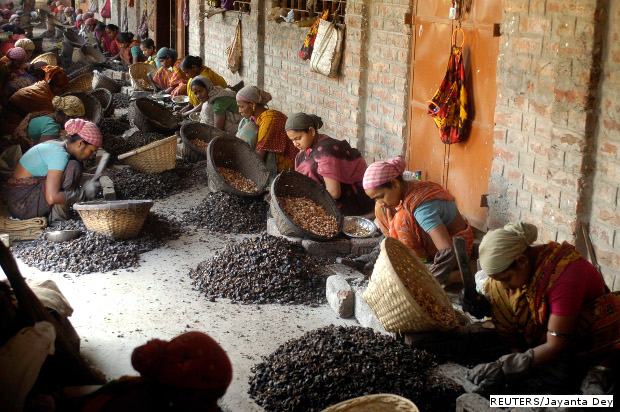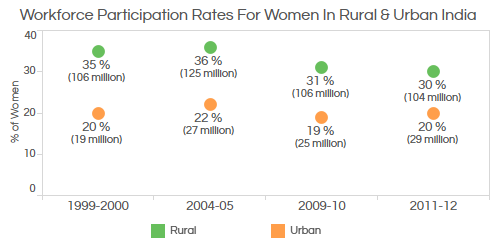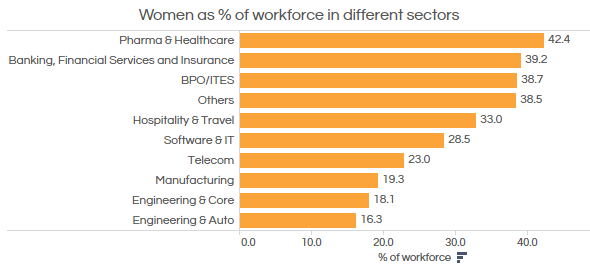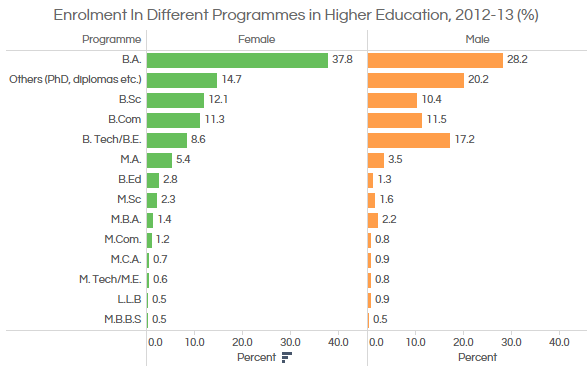Jobs For Women: Why India Does Worse Than Somalia

As Women's Day rolls in and various debates around the Indian woman unfold--such as her role, education, freedom, responsibilities and job prospects--one thing is clear: the percentage of women in India's workforce is declining.
Women’s workforce participation in India is the lowest among the BRICS nations. A range of countries, such as Bahrain, Malaysia and even Somalia (37%) do much better.
The total workforce participation rate (WPR) for women in 2011 was 25.5%, with the WPR for women in rural India at 30% and women in urban India at 15.4%. In contrast, WPR for men in rural and urban areas were 53% and 53.8% respectively.
Economists and sociologists cite many reasons for the low and--as we shall see--falling rate of women in the workforce including: dropping out for further education, raising children and family pressure.
Most of those who remain, have no choice, as economist Vinoj Abraham has concluded in two studies.
"Those who do enter and remain in the labour market are women from the most vulnerable households, as marginalised informal paid labour, thus feminising the most precarious forms of labour in the country," writes Abraham in Economic and Political Weekly.
Data bear out his thesis.

Source: National Sample Survey Organisation (68th Round 2011-12)
The percentage of women and their real numbers in the rural workforce fell from 35% to 30% over 11 years, from 1999-2000 to 2011-12, with a brief increase to 36% in 2004-05. The actual numbers declined from 106 million to 104 million.
Over these 11 years, the percentage of women in the urban workforce stayed the same: 20%, although actual numbers rose from 19 million to 29 million.
That rise, according to Abraham’s study, is caused by a spurt in economic growth, largely in urban India, between 1999-2000 and 2004-05, when the growth rate was 6.9% per year.
The majority of female workers in rural areas (80%) work in the agriculture sector. Manufacturing is a distant second at 7.5%, followed by construction (5.2%) and services (7%).
The biggest employer of urban women, at 39%, is the "other services" sector, which includes domestic work, followed by manufacturing with 27%.
Female workers in India largely comprise unorganised labour, and a vast majority in the unorganised informal sector include those engaged in agriculture, as low-paid subsistence workers, a market susceptible to economic shocks.
The decline in female employment in the second half of the decade is a reflection of their declining numbers in agriculture, the unorganised sector and those who are self-employed.

Source: Confederation of Indian Industry
In urban India, women are a minority in most industries, even in the service sector, where they tend to be in more visible roles.
Core engineering and automobile sectors have the least representation of female workers, employing 16% and 18% respectively.
The highest number of women are in pharmaceuticals and healthcare: 42.4%. This situation spotlights the fact that most women working in urban areas are not skilled.
The poorest, the desperate and the stereotypical
A third of urban women workers are illiterate, as compared to 11 % of men.
Women in urban areas are engaged primarily in services like public administration, health, education, domestic workers, followed by trade and manufacturing.
Gender-based disparities exist in technical and vocational education and training, with girls accounting for just 7% of enrolment at the secondary level, concentrated in some stereotypical courses such as nursing and sewing.
In urban areas, 2.9% of women are technically educated, as compared to 7% of men.

Source: AISHE Portal
The table above indicates that 73% of women are enrolled in under-graduate courses, while 27% are enrolled in post-graduate courses. Fewer women enrol in post-graduate courses, as compared to men.
In post-graduate courses, 14.7% are enrolled in other courses (PhD, MPhil, diplomas and certificate courses).
In an earlier IndiaSpend analysis, we found that women were dropping out of higher education programmes in several states, even in richer states, such as Kerala and Gujarat.
This trend proves studies conducted by the Institute for Applied Manpower and Research (IAMR), which said that lower participation in technical education and high drop-out rates from higher education affect female participation in the workforce.
Reproductive roles, household and care responsibilities, cultural sanctions and patriarchal hierarchies play a major role. Continuing education and migration after marriage are also reasons for the withdrawal of women from the labour force.
"The sharp decline in female employment has raised concerns among policy makers regarding gender equality, women empowerment, and women livelihood strategies," said the IAMR study. "Women’s employment is a critical factor in their economic empowerment and their overall status in society."
(Prachi Salve and Saumya Tewari are policy analysts with IndiaSpend)
__________________________________________________________________________
“Liked this story? Indiaspend.org is a non-profit, and we depend on readers like you to drive our public-interest journalism efforts. Donate Rs 500; Rs 1,000, Rs 2,000.”


